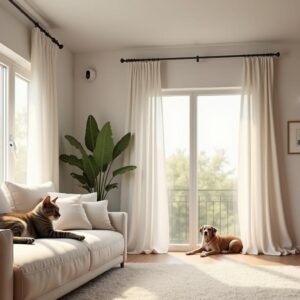Energy-efficient windows are a valuable investment that can significantly enhance comfort while reducing utility expenses. They minimize heat transfer, keep indoor temperatures stable, and help cut down on energy consumption. When selecting these windows for your home, you’ll want to consider everything from glass coatings to window frame materials. Below you’ll find insights on some of the factors that shape window efficiency and how to choose solutions suited to your space.
Contents
- 1 Why investing in insulated windows enhances comfort
- 2 Features that set double glazed windows and triple glazed windows apart
- 3 Evaluating window frame materials for improved energy-saving glass
- 4 Selecting cost-effective windows for residential energy efficiency
- 5 Considering additional features for enhanced performance
- 6 Looking at long-term functionality and window energy ratings
- 7 Additional ways to optimize window performance
- 8 Planning for long-term benefits
Why investing in insulated windows enhances comfort
Insulated windows provide multiple layers of protection against outdoor temperatures. They often feature specialized coatings and gas fills between panes to retain warm or cool air inside. That means you can expect a steadier indoor environment and fewer drafts. Because these windows reduce temperature fluctuations, you won’t have to keep adjusting the thermostat. Over time, the consistent temperature control helps trim heating and cooling bills.
Superior thermal protection
The notion of thermal insulation goes beyond simply keeping a house warm in winter. Effective insulation also limits heat gain in summer, creating year-round comfort. By preventing heat loss prevention in colder months and heat infiltration during hotter periods, insulated glass and properly sealed frames can keep living spaces comfortable without demanding excessive energy use. This approach supports air leakage reduction as well, which is vital for lower costs and better indoor air quality.
Features that set double glazed windows and triple glazed windows apart
Double glazed windows add an extra layer of glass compared to single-pane models, boosting overall window performance. The space between the panes can be filled with air or an inert gas such as argon to limit thermal transfer. These designs also reduce exterior noise and improve your home’s indoor ambiance. Less sound infiltration creates a quieter interior, so you can relax without external disruptions.
Triple glazed windows go a step further by including yet another pane. That extra layer, combined with argon-filled windows in each gap, often translates to a higher R-value. A higher R-value means more robust insulation, stronger UV protection, and enhanced resistance to condensation. However, it’s essential to assess whether the added cost is warranted by your local climate and personal needs.
Considering solar gain and low-e glass
When comparing double and triple glazed windows, you’ll come across references to solar gain and low-e glass. Low-emissivity coatings act as invisible shields that reflect heat while letting light pass through. In cooler climates, you might want coatings that encourage solar gain to help warm interior spaces. In hotter regions, coatings that focus on reflecting solar heat typically perform better. Striking this balance ensures you maximize energy savings without sacrificing natural light.
Evaluating window frame materials for improved energy-saving glass
The frame is a critical part of your window’s overall efficiency. While glass choice is crucial, the surrounding material plays a major role as well. Wood frames provide excellent insulation but may require regular upkeep. Vinyl frames are popular because they’re low-maintenance and insulate effectively. Aluminum frames hold up well in diverse weather conditions but can sometimes conduct heat unless outfitted with a thermal break. Composite frames combine the durability of man-made materials with the sleek look of wood.
Minimizing thermal bridging
Thermal bridging happens when a higher-conductivity material (like some types of metal) lets heat bypass the insulation in the window assembly. Frames designed with internal barriers can disrupt this effect and enhance the window’s ability to keep your indoor temperature stable. Quality window sealant around the perimeter can further improve airtightness. Pairing your preferred frame type with energy-saving glass helps maintain the right balance of aesthetics, performance, and upkeep.
Selecting cost-effective windows for residential energy efficiency
It’s easy to assume that the most expensive window is the best option. Yet cost-effective windows can perform impressively if they match your specific conditions. Start by looking at window efficiency ratings: these measurements help you compare how different products manage heat flow and light transmission. Labels from organizations such as Energy Star windows can also guide you toward models that pass rigorous efficiency standards.
An important aspect of cost-effectiveness is factoring in the window’s lifespan and savings on energy bills. Even if you pay a bit more initially, high-performance windows can pay you back over time through reduced heating and cooling costs. Evaluate your climate and regional demands to see if you need the advanced capabilities found in triple pane windows or if double glazed models are sufficient.
Ensuring correct window installation
Proper window installation directly impacts performance. Even the best windows in the market won’t perform well if installed incorrectly. Gaps and misalignments can lead to air leakage, undermining the window’s design benefits. If possible, work with professionals who carry out both installation and energy audit windows services. That extra step helps confirm your home’s unique needs, ensuring the windows you choose line up perfectly with your living spaces.
Considering additional features for enhanced performance
Sometimes, small details make a big difference in daily life. This could be an internal window film that offers UV protection, or solar control windows designed to manage sunlight exposure. Window film can further reduce glare and limit harmful UV rays, protecting furniture from fading. Meanwhile, solar control windows include specialized coatings tailored to your region’s climate, managing the balance of heat entering your home.
Air leakage prevention
Air leakage is one of the more subtle reasons that windows can end up letting your indoor temperature slip away. High-grade window frames typically include weatherstripping that’s both sturdy and flexible. Combine that with quality glazing technology, and you’ll keep your home well-sealed against the elements. Replacing worn-out seals is also a necessary part of maintenance, preserving the long-term performance of your eco-friendly windows.
Looking at long-term functionality and window energy ratings
Energy-efficient designs start paying off once you see your utility bills shrinking, but durability matters too. High-performance windows should stand up to temperature extremes and everyday wear without losing their insulating properties. Over time, any compromised seal will let air seep in, diminishing your original investment. Periodic checks ensure proper functionality and help you act quickly if repairs are needed.
Window energy ratings take into account several aspects, from how effective the window is at stopping heat transfer to the degree of visible light it admits. As you compare various ratings, bear your location in mind. A window that ranks highly for one region might be less beneficial in another with a different climate profile. Matching your windows to local conditions supports overall building energy performance.
Exploring sustainable windows
Environmental considerations come into play for many homeowners seeking energy-efficient windows. Sustainable windows often emphasize recyclable materials and low-impact manufacturing processes. They might also feature advanced coatings that reduce your reliance on mechanical heating and air conditioning. In some cases, your local authorities could provide rebates or incentives for installing windows designed to conserve energy. By combining eco-friendly production methods with day-to-day energy savings, your home can reach the next level of sustainability.
Additional ways to optimize window performance
Beyond picking the right window, there are a few extra steps you can take. Inspect for cracks or gaps around the sashes. A small opening might seem insignificant, but it can allow cold drafts in winter or let air-conditioned air escape in summer. Sealing these cracks with weatherstripping or specialized caulk can make a fast impact on your comfort. Some homeowners also install exterior shading devices to regulate how much sunlight enters their home.
If you’re comparing multiple window designs, a quick consultation with experts in window installation could clarify the differences. These professionals can discuss how well each choice supports your home’s ventilation needs and energy demands. They might even help you identify small tweaks that improve insulation without requiring a full window replacement.
Balancing aesthetics and efficiency
One common hesitation is whether upgrading to energy-saving glass might limit decorative possibilities. However, modern window technology offers various styles, trims, and finishes that complement almost any architectural design. Whether you prefer sleek aluminum frames or traditional wooden fixtures, there are numerous customization options. Just ensure that your window frames and glazing choices align with your efficiency goals to keep both appearance and performance on point.
Planning for long-term benefits
Switching to more efficient windows isn’t just about slashing monthly bills. It can also raise your home’s overall value and boost indoor comfort. The right selection can reduce outdoor noise, cut glare, and enhance security. When you consider the full life span of each window, paying attention to maintenance and manufacturer guarantees is wise. Some companies offer extended warranties on frame materials or glass seals, which can be particularly appealing if you expect harsh weather conditions.
In many homes, older windows are a significant source of wasted energy. Upgrading to modern, energy-efficient designs offers a straightforward way to reduce your carbon footprint. That shift not only saves you money but also supports broader environmental goals. By choosing windows tailored to your local climate, investing in quality installation, and supporting these decisions with occasional inspections, you set up your property to thrive in all seasons.





